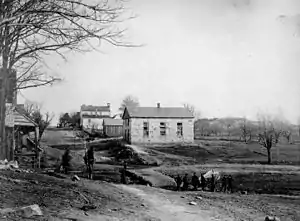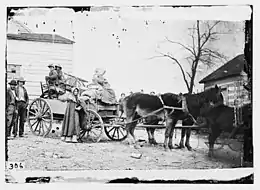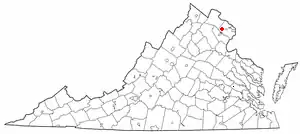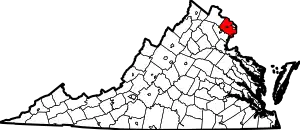Centreville, Virginia
Centreville is a census-designated place (CDP) in Fairfax County, Virginia, United States and a suburb of Washington, D.C. The population was 71,135 at the 2010 census.[3] Centreville is approximately 20 miles (32 km) west of Washington, D.C.
Centreville, Virginia | |
|---|---|
Census-designated Place (CDP) | |
_from_an_airplane_heading_for_Washington_Dulles_International_Airport_passing_over_Virginia_State_Route_28_in_Centreville%252C_Fairfax_County%252C_Virginia.jpg.webp) | |
 Location of Centreville in Fairfax County, Virginia | |
 Centreville, Virginia Location of Centreville in Fairfax County, Virginia  Centreville, Virginia Centreville, Virginia (Virginia)  Centreville, Virginia Centreville, Virginia (the United States) | |
| Coordinates: 38°50′33″N 77°26′33″W | |
| Country | United States |
| State | Virginia |
| County | Fairfax |
| Area | |
| • Census-designated Place (CDP) | 12.04 sq mi (31.2 km2) |
| • Land | 11.93 sq mi (30.9 km2) |
| • Water | .12 sq mi (0.3 km2) |
| Elevation | 383 ft (117 m) |
| Population (2010) | |
| • Census-designated Place (CDP) | 71,135 |
| • Density | 5,908/sq mi (2,281/km2) |
| • Urban | 4,190,000 |
| • Metro | 5,139,549 |
| Time zone | UTC-5 (EST) |
| • Summer (DST) | UTC-4 (EDT) |
| ZIP codes | 20120-20122 |
| Area code(s) | 703, 571 |
| FIPS code | 51-14440[1] |
| GNIS feature ID | 1491083[2] |
History
Colonial period
Beginning in the 1760s, the area was known as Newgate due to the popularity of the conveniently-located Newgate tavern. William Carr Lane operated the tavern and was co-proprietor of a nearby store with James Lane, Jr.[4] The Lanes sold convicted servants, which may explain why the tavern had the same name as a London prison.[5] The small stream that passed near the tavern was named the River Thames, another London association.[6] Another reason for it being named Newgate, was the fact that it was a "new gate" to the western territories.
Federal period
The town of Centerville (shortly thereafter spelled Centreville) was established in 1792 on the turnpike road at the village of Newgate by the Virginia General Assembly in response to petitions by local landowners.[7] The petitioners reasoned that a town on the turnpike road leading from the Northwest Territory and centrally located to Alexandria, Colchester, Dumfries, Middleburg, George Town (later Georgetown), Fauquier Court House (later Warrenton), and Leesburg would be convenient. The town acquired its name due to its central location. James Hardage Lane, one of the landowners, conceived the idea of the town as a way to provide financial support to his widow and their children.[8] At the town's inception, it was within the boundary of Loudoun County, Virginia, and became part of Fairfax County, Virginia, in 1798 when the boundary between the two counties shifted.[9]
Town development established a pattern of mixed residential and commercial use. Frame houses, several taverns, stores, blacksmith shops, tanyards, and a school house were constructed on the 1/2-acre town lots.
Civil War


In the Civil War, several battles were fought nearby including the First Battle of Manassas, the Second Battle of Manassas, and the Battle of Chantilly. During the winter of 1861 and early 1862 the town was significantly fortified by the Confederacy and served as a supply depot for both sides at various points in the war, and is famous for being the site of the construction of the first railroad ever built exclusively for military use, the Centreville Military Railroad. Centreville was of significant strategic value due to its proximity to several important roads, while its position atop a high ridge provided a commanding view of the surrounding area. The town was frequently associated with Confederate Colonel John S. Mosby, whose partisan rangers used its hillsides and farms as a base of operations, leading to the sobriquet "Mosby's Confederacy".
Modern
In 1943, Centreville was a small town. As in much of Northern Virginia, Centreville experienced sustained population growth in the 1990s and 2000s.
Geography

Centreville is located at 38°50′33″N 77°26′33″W (38.842470, −77.442621).[10]
According to the United States Census Bureau (2010), the CDP has a total area of 12.04 square miles (31.2 km2), 99% of it land.
Demographics
| Historical population | |||
|---|---|---|---|
| Census | Pop. | %± | |
| 1980 | 7,473 | — | |
| 1990 | 26,585 | 255.7% | |
| 2000 | 49,789 | 87.3% | |
| 2010 | 71,135 | 42.9% | |
| source:[11][12] | |||
As of the 2010 census,[1] there is a population of 71,135 people and 25,516 households in the CDP. The population density was 5,908/sq mi people per square mile (2,281/km2). The racial makeup of the CDP was 57.0%% White, 25.7% Asian, 7.5% African American, 0.3% Native American, 0.1% Pacific Islander, and 4.4% from two or more races. Hispanic or Latinos of any race were 13.4% of the population.
According to the 2000 census, there were 21,789 households, out of which 41.5% had children under the age of 18 living with them, 54.0% were married couples living together, 10.4% had a female householder with no husband present, and 32.0% were non-families. 21.5% of all households were made up of individuals, and 2.1% had someone living alone who was 65 years of age or older. The average household size was 2.74 and the average family size was 3.27.
In the CDP, the population was spread out, with 28.4% under the age of 18, 8.2% from 18 to 24, 43.7% from 25 to 44, 16.4% from 45 to 64, and 3.3% who were 65 years of age or older. The median age was 31 years. For every 100 females, there were 97.6 males. For every 100 females age 18 and over, there were 94.6 males.
According to a 2007 estimate,[13] the median income for a household in the CDP was $87,932, and the median income for a family was $105,803. Males had a median income of $70,123 versus $41,117 for females. The per capita income for the CDP was $40,878. About 2.0% of families and 1.0% of the population were below the poverty line, including 3.0% of those under age 18 and 1.7% of those age 65 or over.
Transportation
_between_Pickwick_Road_and_Union_Mill_Road-Centreville_Farms_Road_in_Centreville%252C_Fairfax_County%252C_Virginia.jpg.webp)
Centreville is served by three major roads. U.S. Route 29, the main artery through the town, enters Centreville from the west. Virginia Route 28 enters from the south and interchanges with U.S. Route 29 in between Centreville's two main shopping centers. SR 620 (Braddock Road) has several stretches of pavement in Centreville. Interstate 66 comes from the south-west and interchanges with both routes before heading toward Washington, D.C. in the east or western Virginia. The three roads are part of an interesting, if not frustrating traffic pattern. Drivers heading north on SR 28 are able to exit onto Interstate 66 eastbound, but they must use a one-mile (1.6 km) stretch of US 29 to access the westbound side of the Interstate. Likewise, eastbound Interstate 66's Exit 53 only provides access to SR 28 northbound; one must use Exit 52 and the same stretch of US 29 to reach SR 28 south.[14]
The area is served by several Fairfax Connector bus routes connecting to the Metrorail system: 640, 641, 642.
Notable people
- Corbyn Besson, Popular singer, member of the band Why Don’t We, graduate of Centreville High School.
- Chris Beatty, American football coach
- Jayson Blair, former New York Times journalist accused of plagiarism; attended Centreville High School
- David L. Brewer III, retired U.S. Navy admiral and former superintendent of the Los Angeles Unified School District
- Mike Glennon, American football player for the Tampa Bay Buccaneers
- Sean Glennon, former American football player for Virginia Tech
- Abul Hussam, inventor of the SONO™ arsenic filter and winner of the National Academy of Engineering 2007 Grainger Challenge Prize Gold Award[15]
- George Juskalian, decorated U.S. Army officer and veteran of World War II, the Vietnam War, and the Korean War
- S.C. Megale, author and screenwriter
- Will Montgomery, NFL football player; graduate of Centreville High School
- Dustin Pague, professional mixed martial artist
- Ludacris, American rapper and actor; attended Centreville High School for one year.[16]
- Eddie Royal, wide receiver for the Chicago Bears; graduated from Westfield High School
- Scott Secules, NFL football player[17]
- Brandon Snyder, MLB 1st round draft pick in 2005 by the Baltimore Orioles; attended Westfield High School[18]
- Ormond Stone, astronomer, mathematician, and educator who founded the Fairfax County Public Library
- Richard Taylor, professional American football player
- William J. Thaler, experimental physicist
- Don Warren, former professional American football player
- Sebra Yen, figure skater
- Helon Habila, professor and author
Education
Primary and secondary schools
Residents of Centreville are zoned to schools in the Fairfax County Public Schools.
Centreville has two middle schools, Liberty Middle School and Ormond Stone Middle School. Some Centreville middle school students also go to Rocky Run Middle School.
Centreville High School, which is located within the postal boundaries of Clifton, serves much of Centreville. Some of Centreville is served by Chantilly High School and by Westfield High School, the latter opening in 2000. Both Chantilly High School and Westfield High School are located in Chantilly.
The only high school still within Centreville proper is Mountain View Alternative High School. It occupies the building formerly used by Centreville Elementary School.
Although a Loudoun County school, Cardinal Ridge Elementary has a Centreville address.
Public libraries
Fairfax County Public Library operates the Centreville Regional Library in the CDP.[19][20]
Nearby towns, communities, etc.
- Chantilly-South Riding (1 mile NW)
- Clifton (5 miles SE)
- Fair Lakes (4.5 miles E)
- Manassas (6 miles S)
External links
| Wikimedia Commons has media related to Centreville, Virginia. |
Notes
- "U.S. Census website". United States Census Bureau. Retrieved 2008-01-31.
- "US Board on Geographic Names". United States Geological Survey. 2007-10-25. Retrieved 2008-01-31.
- U.S. Census website website at factfinder2.census.gov. Accessed 2011-09-09.
- William Carr Lane obtained an ordinary (tavern) license in 1768, Loudoun County Court Order Book of 1768.
- Virginia Gazette, Publisher: Rind, p.2, col.3, 1771-01-17 "Archived copy". Archived from the original on 2009-06-27. Retrieved 2009-07-11.CS1 maint: archived copy as title (link)
- Town plat, Library of Virginia
- John Stuart Alexander, and Others, Legislative Petitions, Loudoun County, October 3, 1792, Reel 111, Box 142, Folder 39, Library of Virginia. (Second petition)
- John Stuart Alexander, and Others, Legislative Petitions, Fairfax County, November 20, 1790, Reel 49, Box 69, Folder 36, Library of Virginia
- Sweig, Donald (1992). Fairfax County Virginia: A History. Fairfax County Board of Supervisors, Fairfax, Virginia, p.45. ISBN 0-9601630-1-8
- "US Gazetteer files: 2010, 2000, and 1990". United States Census Bureau. 2011-02-12. Retrieved 2011-04-23.
- "CENSUS OF POPULATION AND HOUSING (1790–2000)". U.S. Census Bureau. Retrieved 2010-07-17.
- Population recorded when the census tabulated figures of unincorporated places for the first time. 1880 Census of Population
- Centreville CDP, Virginia – Fact Sheet Archived 2020-02-11 at Archive.today. American FactFinder. US Census Bureau.
- Layla Wilder, Loudoun Times, Frey OKs Route 28 median Archived 2008-01-28 at the Wayback Machine 12 April 2007; accessed 13 October 2007
- "CHEM 321 - Quantitative Chemical Analysis". gmu.edu. Archived from the original on 26 September 2015. Retrieved 18 August 2015.
- "Ludacris tells Lindsay Czarniak that he attended Centreville High School for a year". Washington Post.
- "Scott Secules". Pro-Football-Reference.com. Retrieved 18 August 2015.
- BaseballAmerica – stats for Brandon Snyder
- "Library Branches." Fairfax County Public Library. Retrieved on October 21, 2009.
- "Centreville CDP, Virginia." U.S. Census Bureau. Retrieved on October 21, 2009.
